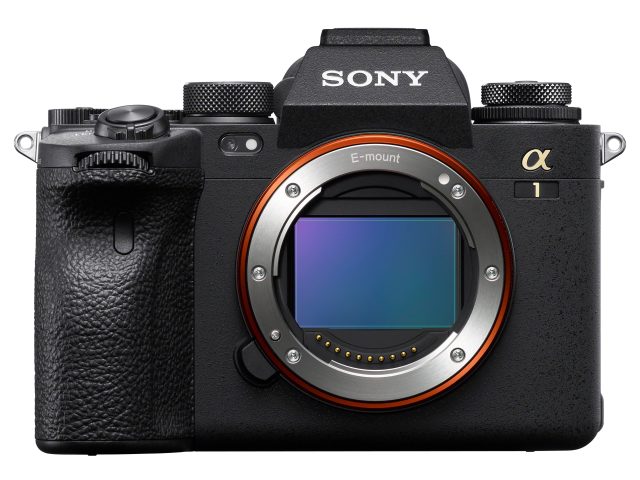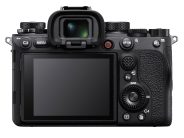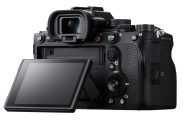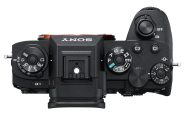Announced
Production status
System
Sony a1
35mm AF digital mirrorless camera
Specification
| Format: | |
| 35mm full frame | |
Imaging sensor: | 35.9 × 24mm CMOS sensor |
Resolution: | 8640 × 5760 - 50 MP |
Sensor-shift image stabilization: | Yes |
| Sony E [18mm] | |
| Shutter: | |
Type: | Focal-plane |
Model: | Electronically controlled |
Speeds: | 30 - 1/32000 + B |
| Exposure: | |
Exposure metering: | Through-the-lens (TTL), open-aperture |
Exposure modes: | Programmed Auto |
| Aperture-priority Auto | |
| Shutter-priority Auto | |
| Manual | |
| Physical characteristics: | |
Weight: | 737g |
Dimensions: | 128.9x96.9x80.8mm |
Manufacturer description
SAN DIEGO, CA – January 26, 2021 – Sony Electronics, a global leader in imaging sensor technology and digital imaging, has announced the arrival of the groundbreaking new full-frame mirrorless Alpha 1 camera – asserting their commitment to leading the industry with a stunning combination of innovative new features.
The most technologically advanced, innovative camera that Sony has ever released, the Alpha 1 combines high-resolution and high-speed performance at a level that has never been accomplished in the world of digital cameras. With a brand new 50.1-megapixel full-frame stacked Exmor RS™ image sensor, up to 120 AF/AE calculations per second, 8K 30p 10-bit 4:2:0 video and much more, the Alpha 1 will allow creators to capture what they’ve never been able to before.
"We are always listening to our customers, challenging the industry to bring new innovation to the market that goes far beyond their expectations.” said Neal Manowitz, deputy president for Imaging Products and Solutions Americas at Sony Electronics. “Alpha 1 breaks through all existing boundaries, setting a new bar for what creators can accomplish with a single camera. What excites us the most – more than the extensive product feature – is Alpha 1's ability to capture that which has never been captured before. This camera unlocks a new world of creative possibilities, making the previously impossible now possible.”
The newly developed image sensor is built with integral memory and paired with an upgraded BIONZ XR imaging processing engine, making it capable of shooting 50.1-megapixel images continuously at an astounding 30fps with up to 120 AF/AE calculations per second. The Alpha 1’s shooting capabilities are further enhanced by a 9.44 million dot OLED Quad-XGA electronic viewfinder, with a refresh rate of up to 240 fps[xiv], ensuring no black out. Additionally, for the first time in an Alpha series camera, 8K 30p 10-bit 4:2:0 video is available. The Alpha 1 is also capable of 4K 120p / 60p 10-bit 4:2:2 recording and includes S-Cinetone color. The Alpha 1 is also packed with features that support field professionals with faster workflow, including 3.5 times faster wireless FTP transfer speed[xv] and more.
Unprecedented Resolution and Speed
Continuous Shooting at Up to 30 Frames Per Second
The Alpha 1 captures moments that would otherwise be lost thanks to its high-speed performance, providing any photographer the speed they require to capture fast-moving objects. High speed readout from the 50.1-megapixel image sensor and a large buffer memory make it possible to shoot up to 155 full-frame compressed RAW images[xvi] or 165 full-frame JPEG images[xvii] at up to 30 frames per second with the electronic shutter while maintaining full AF and AE tracking performance[xviii].
At an astonishing calculation speed of up to 120 AF/AE per second, the Alpha 1 can maintain focus with high accuracy even for fast moving subjects. It can automatically adjust exposure, even with sudden changes in brightness, with an AE response latency as low as 0.033 seconds[ii].
Advanced Electronic Viewfinder with the World’s Firstiv Refresh Rate of 240 fps
Complimenting the camera’s ability to capture images at an unprecedented speed, the Alpha 1 viewfinder features the world’s first[iv] 240 fps refresh ratexiv, for a super-smooth display. The viewfinder does not black out when an exposure is made to offer an uninterrupted view and allow for seamless framing and tracking, even during continuous shooting. The 9.44 million-dot (approx.), 0.64 type Quad-XGA high-definition OLED display and refined optics deliver the highest resolution in its classiv. It also offers 0.90x[xix] viewfinder magnification, a 41° diagonal FOV, and a 25mm-high eyepoint for clear, low distortion viewing from corner to corner.
Advanced Autofocus
Sony continues to push the boundaries of autofocus technology with the introduction of the Alpha 1, which can easily track complex, fast-moving subjects with high precision. The camera features 759 phase detection points in a high-density focal plane phase-detection AF system cover approximately 92% of the image area – ensuring accuracy and unfailing focus in environments where focusing might otherwise be difficult.
Sony’s advanced Real-time Eye AF improves detection performance by 30% over the previous system[i], thanks to the powerful image processing engine, BIONZ XR. It ensures accurate, reliable detection, even when the subject’s face looks away. In addition to improved Real-time Eye AF for humans and animals, the Alpha 1 employs high-level subject recognition technology to provide Real-time Eye AF for birds[xi], a first in an Alpha series camera. Optimized algorithms ensure that tracking is maintained even if a sitting bird suddenly takes flight, or the framing suddenly changes[xx].
The Alpha 1 also features AI-based Real-time Tracking that automatically maintains accurate focus. A subject recognition algorithm uses color, pattern (brightness), and subject distance (depth) data to process spatial information in real time at high speed.
Silent, Vibration-free Electronic Shutter
High-speed readout from the new image sensor has made it possible to reduce rolling shutter by up to 1.5 times when shooting stills, compared to the Alpha 9 II. It also offers silent anti-flicker continuous shooting with an electronic shutter for the first time[v] in the world. The electronic shutter[xxi] operates silently, without mechanical noise, and is vibration-free. Stress-free continuous shooting is now possible even when shooting in challenging lighting situations with florescent or other flicker-prone types of artificial lighting. And for the first time in an Alpha camera, electronic shutter flash sync up to 1/200 sec[xxii] is possible. The advantages of the electronic shutter advantages can now come to life even when using flash for broadly expanded shooting versatility.
Dual Driven Shutter System for 1/400 Flash Sync
The Alpha 1 boasts the world’s fastest flash sync speed[v] of 1/400 sec. with mechanical shutter, making it even easier to capture dynamic action. In addition to a carbon fiber shutter curtain, the Alpha 1 features the newly developed dual driven shutter system utilizing spring and electromagnetic drive actuator, offering high durability and lightness at the same time.
High Resolution Shooting Enhancements
Even with this sensor’s high pixel count, the Alpha 1 offers high sensitivity with low noise, plus 15+ stops of dynamic range for video and 15 stops for stills, for smooth, natural gradations from shadows to highlights thanks to its cutting-edge processing system, throughout a wide ISO sensitivity range of 100-32,000 (expandable to 50-102,400, when shooting stills).
Additionally, the new camera features an evolved Pixel Shift Multi Shooting mode that composites up to 16 full-resolution images. In this mode, the camera precisely shifts the sensor in one pixel or half-pixel increments to capture 16 separate pixel-shifted images containing a total of 796.2 million pixels of data, which are then composited into a 199 million pixel (17,280 x 11,520 pixels) image using Sony’s Imaging Edge™ desktop application. With a flash sync of up to 1/200 sec. in this mode, it is ideal for photographing architecture, art or any other still life subject with a level of detail and color accuracy that is simply stunning.
Professional Video Quality
8K High-resolution Movie Shooting
For the first time in an Alpha camera, the Alpha 1 offers 8K 30p 10-bit 4:2:0 XAVC HS recording with 8.6K oversampling for extraordinary resolution. Combined with Sony’s acclaimed autofocus technology, gradation and color reproduction performance, the Alpha 1 will help the user realize their creative vision with the finest detail. It’s 8K footage can also be used for flexible 4K editing during post-production.
Supporting Various Video Formats for Professionals
The Alpha 1 offers in-camera 4K recording at up to 120 frames per second[viii] which allows the user to shoot up to 5X slow-motion video[xxiii]. In addition to supporting 10-bit 4:2:2 recording, this feature can be used with efficient Long GOP inter-frame compression or high-quality Intra (All-I) intra-frame compression.
The Alpha 1 features S-Cinetone, the same color matrix that produces the highly regarded FX9 and FX6 color and skin tones. It delivers natural mid-tones, plus soft colors and gorgeous highlights to meet a growing need for more expressive depth. The S-Log3 gamma curve makes it possible to achieve 15+ stops of dynamic range, while the S-Gamut3 and S-Gamut3.Cine color gamut settings make it easy to match Alpha 1 footage with video shot on VENICE cinema camera, FX9 and other professional cinema cameras.
Heat-dissipating Structure
A unique heat dissipating structure keeps image sensor and image processing engine temperatures within their normal operating range, preventing overheating while maintaining compact body dimensions. This makes it possible to record 8K/30p video continuously for approximately 30 minutes[xxiv].
Supporting Hand-held Shooting
A high-precision stabilization unit and gyro sensors, plus optimized image stabilization algorithms, achieve up to a 5.5-step shutter speed advantage, maximizing the quality of the high-resolution images derived from the camera’s 50.1-megapixel sensor. The Alpha 1 also features an Active Mode[xxv] that offers outstanding stabilization for handheld movie shooting. When using Sony’s desktop applications Catalyst Browse or Catalyst Prepare[xxvi] for post-production, an accurate image stabilization function is available which utilizes metadata generated by camera's built-in gyro.
Other features that the Alpha 1 offers include; 16-bit RAW output[xxvii] to an external recorder[xxviii] via HDMI for maximum post-production flexibility, a digital audio interface has been added to the camera’s Multi Interface (MI) Shoe for clearer audio recordings from a compatible Sony external microphone, 5.8K oversampled full pixel readout without pixel binning for high-resolution 4K movies in Super 35mm mode and more.
Enhanced Workflow with Network Technologies including Connectivity to 5G Compatible Devices
The Alpha 1 has been designed and configured to support photo and video journalists and sports shooters who need to deliver stills or movies as quickly as possible with advanced connectivity options. It offers several features for fast, reliable file transfers. Industry’s fastest[xiii] built-in wireless LAN allows communication on 2.4 GHz and 5 GHz[xxix] bands with dual antennas to ensure reliable communications. 5 GHz includes 2x2 MIMO support (IEEE 802.11a/b/g/n/ac) offering 3.5 times faster wireless FTP transfer speed than the Alpha 9 II - a notable advantage for news and sports shooters who need to deliver with reliable speed. There is also a provided USB Type-C® connector to support fast data transfer when connected to a 5G mmWave compatible device such as Sony’s Xperia PRO and makes high-speed PC Remote (tethered) data transfer available for smooth handling of large image files. The Alpha 1 also has a built-in 1000BASE-T LAN connector for high-speed, stable data transfers, including remote shooting. FTPS (File Transfer over SSL/TLS) is supported, allowing SSL or TLS encryption for increased data security.
In addition to compressed and uncompressed RAW, the Alpha 1 includes efficient lossless compression with no quality degradation, Lossless Compressed RAW. There is also a new “Light” JPEG/HEIF image quality setting that results in smaller files than the “Standard” setting, allowing faster deliver for news and sports photographers who depend on speed. Along with a versatile range of RAW and JPEG formats, the Alpha 1 includes the HEIF (High Efficiency Image File) format for smooth 10-bit gradations that provide more realistic reproduction of skies and portrait subjects where subtle, natural gradation is essential. Images shot on the Alpha 1 can be trimmed in-camera to a desired aspect ratio, size, or position for versatile usage.
The Alpha 1 is also compatible with a variety of apps, add-ons and tools. With Imaging Edge Mobile and Imaging Edge Desktop[xxx], professionals can easily transfer RAW files and files that use lossless compression and remotely control Touch Tracking and Touch Focus for convenient AF operation. The Transfer & Tagging add-on (Ver. 1.3 or later) can automatically covert voice memos attached to image files to text captions or transfer the files to an FTP server from a mobile device. Desktop applications Catalyst Browse/Catalyst Prepare[xxvi] allow professionals to browse and manage video clips shot by Sony’s camera. In addition, the Remote Camera Tool[xxxi] can remotely change camera settings and shoot from a computer connected via LAN cable and feature a number of refinements for the Alpha 1: faster transfer, touch response, dual slot and HEIF support, and more.
Reliable and Easy Operability
Professional users need more than just refined features and performance. They also need the reliability and durability demanded of any professional tool. The Alpha 1 has two media slots that both support UHS-I and UHS-II SDXC/SDHC cards, as well as new CFexpress Type A cards for higher overall capacity and faster read/write speeds. It also features a durable magnesium alloy chassis, long battery life with the Z-battery which can be extended using the optional VG-C4EM Vertical Grip (sold separately), an improved dust removal feature, shutter close function on power-off to protect image sensor, plus dust and moisture resistance[xxxii] that maximizes reliability in challenging environments. It includes a durable, reliable HDMI Type-A connector, and USB PD (Power Delivery) support, allowing higher power to be supplied from an external source so that users can record for extended periods with minimal internal battery usage.
A revised menu structure provides easier navigation, and touch-responsive menu operation offers fast, more intuitive control with Touch Focus and Touch Tracking on its 3.0 type 1.44 million-dot (approx.) LCD monitor. For easy customization, a subset of the camera’s shooting settings now changes according to the selected shooting mode, making it easier than ever to use different aperture, shutter speed and other settings for shooting stills and movies.



